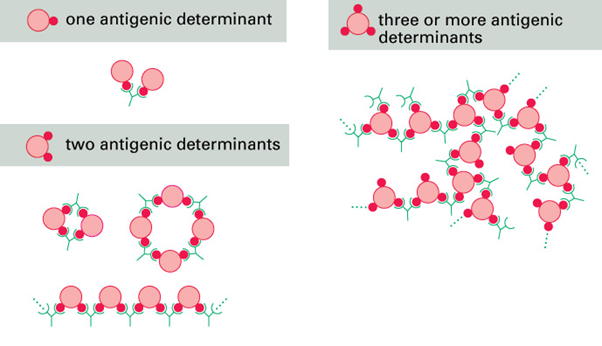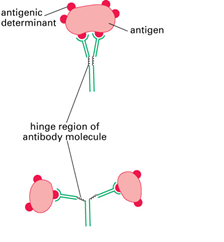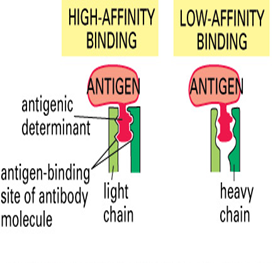• An antigen is any substance that elicits an immune response and is then capable of binding to the subsequently produced antibodies.
• Antigens are generally proteins or polysaccharides, but other substances such as nucleic acids can also be antigens.
What is antibodies?
• An antibody is a protein used by the immune system to identify and neutralize foreign objects like bacteria and viruses. Each antibody recognizes a specific antigen unique to its target.
• Monoclonal antibodies (mAb) are antibodies that are identical because they were produced by one type of immune cell, all clones of a single parent cell.
• Polyclonal antibodies are antibodies that are derived from different cell lines.
What is an antibody?
• An immunoglobulin that is capable of combining with specificity to the antigen that elicited its production.
How, Why and Where are Antibodies Produced?
• Produced in Vertebrate Cells in response to a ‘non-self’ substance termed an antigen.
• The process begins with macrophages roaming the bloodstream. Macrophages engulf ‘non-self’ molecules and then display portions of the engulfed molecules on their outer plasma membranes.
• After many recognition steps B-cells are stimulated to produce specific antibodies.
• The antibodies then go off and bind to the foreign substance thereby marking the substance for destruction.
What is an Epitope?
• An epitope is the small site on the antigen which is recognized by the antibody.
• Usually between one and six sugars or amino acids on the surface of the antigen.
Antibody Uniqueness:
• B-cells produce somewhere between 1 x 108 and 1 x 1010 IgG antibodies with different binding sites.
Antibody-Antigen Interactions:
Binding of antibody to antigen is dependent on hydrogen bonds, electrostatic attractions and Van der Waals attractions.
These bonds are weak compared to covalent bonds but the large number of weak bonds result in a stable complex.
Antibody-antigen binding is reversible.
Binding site differences are due to amino acid sequence differences.
The variable region is made up of 110 â€"130 amino acids.

All immunogens are antigens but not all antigens are immunogens.
Haptens are small molecules that can bind to antibodies but cannot by themselves induce an immune response.
However, the conjugate formed by coupling a hapten to a large carrier protein is immunogenic and elicits production of anti-hapten antibodies when injected into an animal.
Such injections also produce anti-carrier and antihapten/ carrier antibodies as well.
Antibody-Antigen Interactions:
• Binding of antibody to antigen is dependent on hydrogen bonds, electrostatic attractions and Van der Waals attractions.
• These bonds are weak compared to covalent bonds but the large number of weak bonds result in a stable complex.
• Antibody-antigen binding is reversible.
• Binding site differences are due to amino acid sequence differences.
• The variable region is made up of 110 â€"130 amino acids.
• Immunogenicity is determined by many factors including foreignness, molecular size, chemical composition, complexity, dose, susceptibility to antigen processing and presentation,
• The genotype of the recipient animal (in particular, its MHC genes), route of administration, and adjuvants.

ADJUVANTS:
Adjuvants (from Latin adjuvare, to help) are substances that, when mixed with an antigen and injected with it, enhance the immunogenicity of that antigen. Adjuvants are often used to boost the immune response when an antigen has low immunogenicity or when only small amounts of an antigen are available
1. Antigen persistence is prolonged.
2. Co-stimulatory signals are enhanced.
3. Local inflammation is increased.
4. The nonspecific proliferation of lymphocytes is stimulated.

Polyclonal Antibody
• Most B cells will not respond to a particular antigen.
• Each B cell which is activated by an antigen is selected because its antibody binds an epitope on the antigen.
• There are usually many epitopes on an antigen.
• Each epitope stimulates a different B cell. Thus, there is clonal expansion of several different B cells.
• It is said to be a polyclonal antibody response, and the serum containing the mixture of antibodies is called a polyclonal antiserum.
• Produced by immunizing an animal with the appropriate antigen.
• The immunized animal’s serum is collected.
• Antibodies can then be purified from the serum.
• Since one antigen induces the production of many antibodies the result is a ‘polyclonal’ mixture of antibodies.
• Polyclonal antibodies are much less expensive than monoclonal antibodies.
How does antibody staining work?
• Antibody-antigen reaction is highly specific for a given antibody-antigen pair.
• Immunostaining techniques rely on the extreme specificity of an antibody for its antigen.
Indirect vs Direct Antibody Staining:
What is the difference between direct and indirect immunostaining?
• A single secondary detects many primaries so you only need one labeled antibody to be able to visualize the location of large numbers of primary antibodies.
Why do indirect Immunostaining?
• Also, the signal is stronger.
• Cheaper
Polyclonal Antibody Preparation:
• Because T lymphocytes must also be activated in order to help
• a B lymphocyte response, simple molecules, and molecules
• which do not have a protein component are coupled to protein
• carriers like Keyhole Limpet Hemocyanin (KLH).
Adjuvant is used to-
• reduce the rate of clearance of the antigen from the body
• keep it fairly localized
• provide a low non-specific stimulus to the immune system to
• improve antigen presentation and B cell activation.
• Common adjuvants use an oil-aqueous emulsion to trap
• antigen for slow release.
Polyclonal Antibodies:
• Produced by immunizing an animal with the appropriate antigen.
• The immunized animal’s serum is collected.
• Antibodies can then be purified from the serum.
• Since one antigen induces the production of many antibodies the result is a ‘polyclonal’ mixture of antibodies.
• Polyclonal antibodies are much less expensive than monoclonal antibodies.
Monoclonal Antibodies:
• Much more complicated to produce than polyclonal antibodies.
• Process begins by immunizing an animal (most commonly a mouse) with an antigen.
• The animal’s spleen is removed.
• B-cells are fused with myeloma cells resulting in hybridomas.
• Hybridomas are screened to find those producing antibodies to the antigen with which they were immunized.
• Each hybridoma cell is derived from one B-cell so the antibodies that a clonal population of hybridoma cells produce are monoclonal antibodies.
• Monoclonal antibodies recognize one epitope only.
About Author / Additional Info:
I am currently pursuing B. Tech in Biotechnology from National Institute of Technology, Durgapur